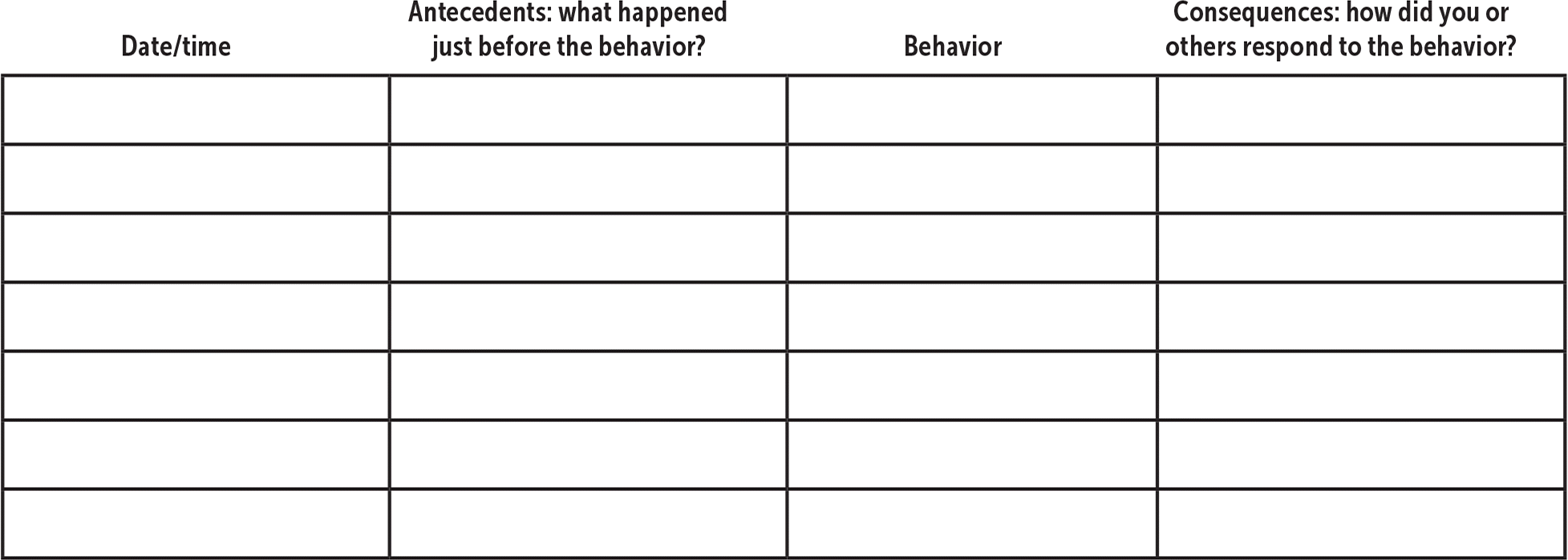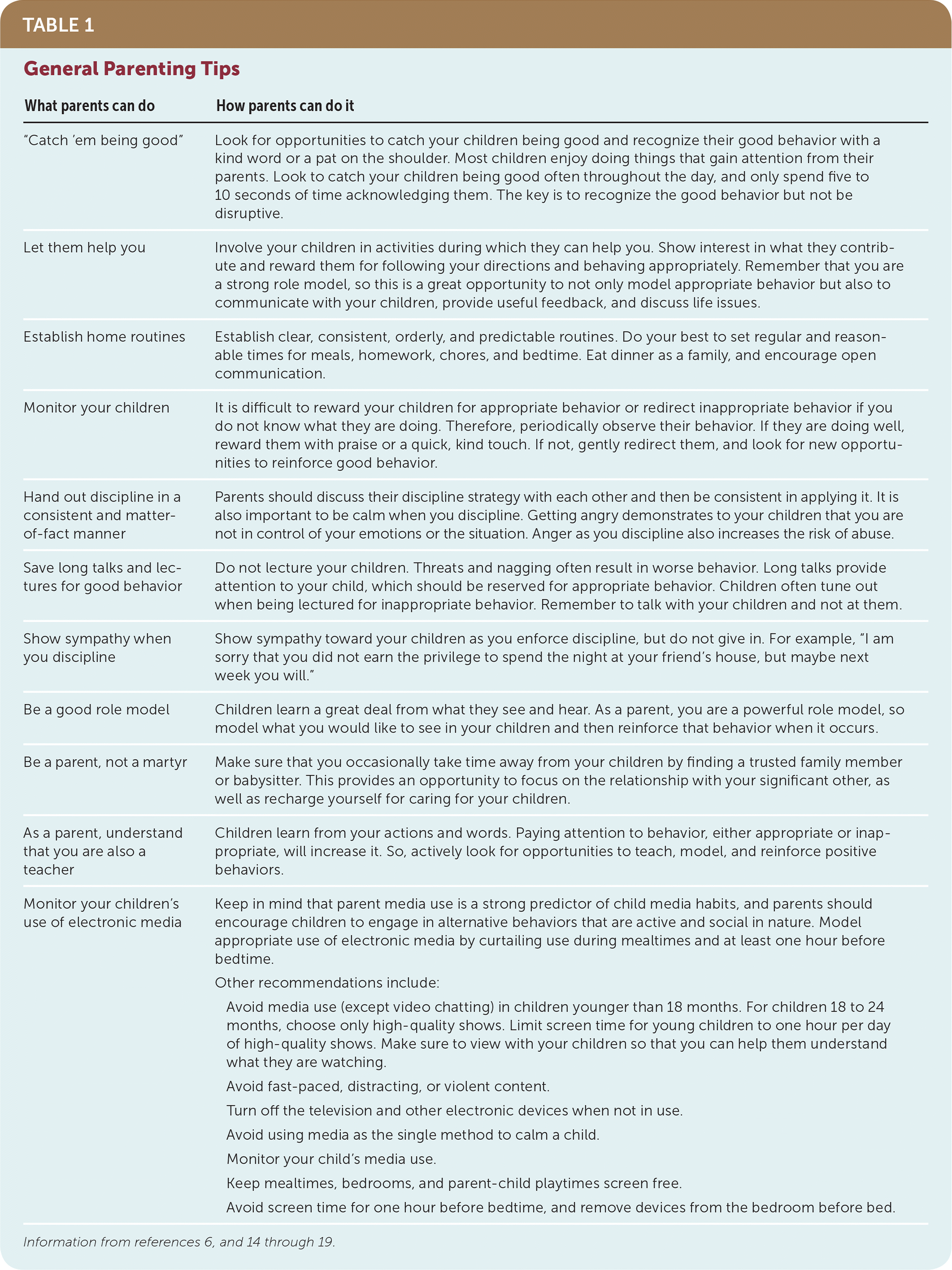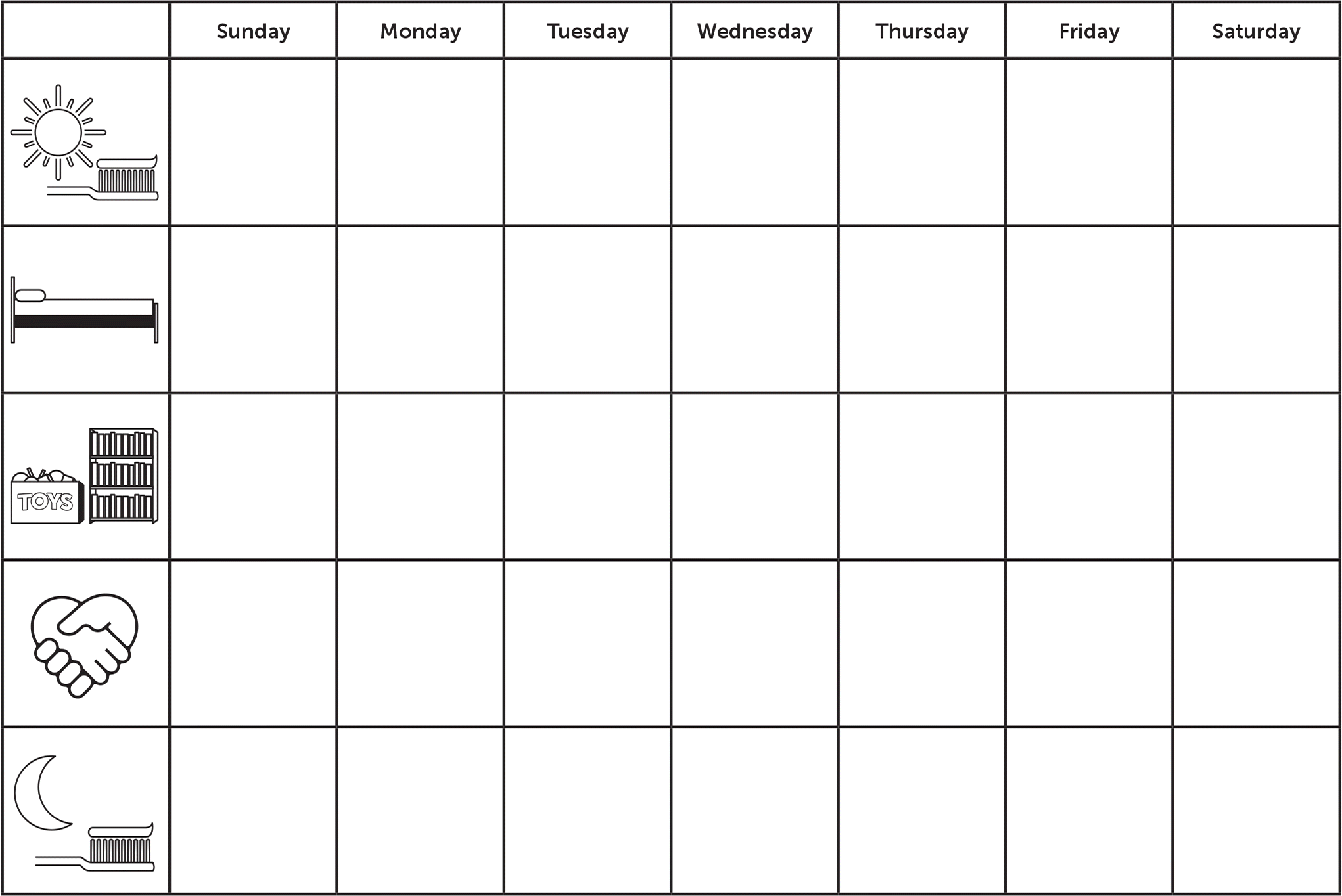
Am Fam Physician. 2018;97(10):642-648
Patient information: See related handouts on using time outs as a parenting technique and general parenting tips, written by the authors of this article.
Author disclosure: No relevant financial affiliations.
Parents often seek guidance from physicians on child behavior problems. Questions may range from general parenting strategies to managing specific child behaviors. Physicians and their staff can identify problematic parent-child interactions or behaviors within the office setting and assist parents by providing effective monitoring tools for behavior problems. Effective strategies for influencing a child's behavior include positive reinforcement to increase appropriate behavior, extinction (planned ignoring) for most low-level problematic behaviors, and time-out from reinforcement for more problematic behaviors. Written contracting provides parents the opportunity to communicate with their children about important behaviors and strengthens the commitment of each party to improve behavior. Parents should be cautioned about the use of punishment (e.g., scolding, taking away privileges or possessions) because it suppresses behavior only temporarily. Physicians should discourage physical or corporal punishment because it is related to negative parent-child relationships, increased aggressiveness, antisocial behavior, lower cognitive ability, lower self-esteem, mental health problems, and increased risk of physical abuse.
Parents often ask physicians about general parenting strategies or management of specific child behavior problems.1–3 Common concerns include problems at bedtime, excessive crying, tantrums, fighting with siblings, and nonadherence to rules.4,5 Children's electronic media use has also become a critical area for physicians to address with parents.6
| Clinical recommendation | Evidence rating | References |
|---|---|---|
| Anticipatory parenting education and interventions, especially reinforcing positive parent-child interactions (e.g., while reading aloud and during play), have a positive impact on a child's behavior, socioemotional development, and later functioning. | B | 10 |
| Monitoring child behavior problems and providing parents with general guidelines on parenting and child behavior management strategies appropriate to the child's age can decrease the likelihood of the child developing further behavior and emotional problems. | C | 13 |
| Effective parent training models share common principles that engage parents as partners with physicians in assessing and managing behavior problems. They also focus on reinforcing positive behaviors, especially while reading aloud and during play; ignoring low-level provocative behaviors; and providing clear, consistent, and safe responses to unacceptable behaviors. | C | 16, 22 |
| Parents should be discouraged from using corporal or physical punishment because of its negative impact on a child's behavior and mental health. | C | 31–35 |
Physician guidance is important because children with behavior and emotional disorders are at greater risk of school failure and dropping out, poor social relationships, abuse, antisocial behaviors, and increased use of health services.7–9 Family physicians can provide anticipatory parenting education and interventions that have a positive impact on a child's behavior, socioemotional development, and later functioning.10
Identification of Child Behavior Problems
Identifying child behavior problems often begins with first contact. Physicians and their staff may note problematic parent-child interactions or behaviors in the waiting or examination room. These may include a child fighting with siblings or other children, poor social skills or withdrawal from strangers, disruptive behavior, parental attention to inappropriate behavior, or parental use of corporal punishment. Parents may also ask physicians about specific developmental issues or problems. The simplest way to assess for problems is for physicians to directly ask parents if they have any concerns regarding their child's social, emotional, or school adjustment.11 If so, additional questions can clarify the problem and lead to a solution. During physical examinations of children, physicians are also urged to look for bruises, burns, welts, or other injuries that may be indicative of abuse, necessitating further inquiry and possible referral to appropriate authorities.12
Once a behavior has been identified for intervention, physicians may ask parents to use several monitoring techniques to track the frequency of the behavior or to help determine potential factors that prompt or worsen the behavior. The simplest monitoring technique involves tracking how often a particular behavior occurs daily. Data may be graphed to show baseline rates, as well as changes across time and after intervention. A more detailed and useful assessment is an ABC chart, or functional analysis, in which parents keep a daily log of the problematic behavior, with the antecedents and consequences to the behavior (Figure 1). This not only provides physicians and parents insight into what factors may be prompting or reinforcing the problematic behavior, but facilitates discussions on how to alter these factors to positively impact the behavior.

Anticipatory Guidance
Certain behavior problems can be anticipated based on the developmental stage of the child. Monitoring child behavior problems and providing parents with general guidelines on parenting and child behavior management strategies appropriate to the child's age can decrease the likelihood of the child developing further behavior and emotional problems.13
Physicians may give parents general parenting guidelines (Table 16,14–19). Parents are encouraged to look for opportunities to reinforce appropriate behaviors, establish home routines, act as teachers and role models for their children, and discipline children in a matter-of-fact manner. In addition, parents are encouraged to monitor and limit their children's use of electronic media and offer alternative activities.6,14–19

| What parents can do | How parents can do it |
|---|---|
| “Catch 'em being good” | Look for opportunities to catch your children being good and recognize their good behavior with a kind word or a pat on the shoulder. Most children enjoy doing things that gain attention from their parents. Look to catch your children being good often throughout the day, and only spend five to 10 seconds of time acknowledging them. The key is to recognize the good behavior but not be disruptive. |
| Let them help you | Involve your children in activities during which they can help you. Show interest in what they contribute and reward them for following your directions and behaving appropriately. Remember that you are a strong role model, so this is a great opportunity to not only model appropriate behavior but also to communicate with your children, provide useful feedback, and discuss life issues. |
| Establish home routines | Establish clear, consistent, orderly, and predictable routines. Do your best to set regular and reasonable times for meals, homework, chores, and bedtime. Eat dinner as a family, and encourage open communication. |
| Monitor your children | It is difficult to reward your children for appropriate behavior or redirect inappropriate behavior if you do not know what they are doing. Therefore, periodically observe their behavior. If they are doing well, reward them with praise or a quick, kind touch. If not, gently redirect them, and look for new opportunities to reinforce good behavior. |
| Hand out discipline in a consistent and matter-of-fact manner | Parents should discuss their discipline strategy with each other and then be consistent in applying it. It is also important to be calm when you discipline. Getting angry demonstrates to your children that you are not in control of your emotions or the situation. Anger as you discipline also increases the risk of abuse. |
| Save long talks and lectures for good behavior | Do not lecture your children. Threats and nagging often result in worse behavior. Long talks provide attention to your child, which should be reserved for appropriate behavior. Children often tune out when being lectured for inappropriate behavior. Remember to talk with your children and not at them. |
| Show sympathy when you discipline | Show sympathy toward your children as you enforce discipline, but do not give in. For example, “I am sorry that you did not earn the privilege to spend the night at your friend's house, but maybe next week you will.” |
| Be a good role model | Children learn a great deal from what they see and hear. As a parent, you are a powerful role model, so model what you would like to see in your children and then reinforce that behavior when it occurs. |
| Be a parent, not a martyr | Make sure that you occasionally take time away from your children by finding a trusted family member or babysitter. This provides an opportunity to focus on the relationship with your significant other, as well as recharge yourself for caring for your children. |
| As a parent, understand that you are also a teacher | Children learn from your actions and words. Paying attention to behavior, either appropriate or inappropriate, will increase it. So, actively look for opportunities to teach, model, and reinforce positive behaviors. |
| Monitor your children's use of electronic media | Keep in mind that parent media use is a strong predictor of child media habits, and parents should encourage children to engage in alternative behaviors that are active and social in nature. Model appropriate use of electronic media by curtailing use during mealtimes and at least one hour before bedtime. Other recommendations include:
|
Management of Child Behavior Problems
Physicians should be knowledgeable about effective strategies to manage child behavior problems and develop collaborative relationships with subspecialists who have expertise in early childhood emotional and behavioral well-being.20,21 In general, effective parent training models share common principles that engage parents as partners with physicians in assessing and managing behavior problems. They also focus on reinforcing positive parent-child interactions, especially while reading aloud and during play 10; ignoring low-level provocative behaviors; and providing clear, consistent, and safe responses to unacceptable behaviors.16,20,22 Once a behavior has been targeted for intervention, a variety of methods are available to assist parents. These include techniques to increase appropriate behavior or decrease inappropriate behavior.
TECHNIQUES TO INCREASE APPROPRIATE BEHAVIOR
Positive Reinforcement. Any event or stimulus that increases the behavior preceding it is considered positive reinforcement.23 For example, if a mother praises her daughter for sharing a toy with her brother, and the sharing behavior subsequently increases, then the parental praise is a positive reinforcer. Likewise, a parent could inadvertently reinforce a child's problematic behavior (e.g., a tantrum) if the parent provides a reinforcer (e.g., attention, candy) to stop the behavior.
Effective reinforcers are brief, occur immediately after the desired behavior, and can be easily repeated in a variety of environments. Although they may differ based on the child, common reinforcers include praise, a smile, a hug, a stroke of the hair, or a gentle pat on the head or shoulder. Parents may also be encouraged to use more tangible reinforcers such as snacks, or secondary reinforcers such as points, stickers, or tokens that can be collected and redeemed for rewards (e.g., one-on-one time with parents, special outings, enhanced privileges). The key is to assist parents in developing reinforcers that are diverse and incentivize their children to engage in good behavior.
Contracting. A contract is a written statement specifying the targeted behaviors that the child is expected to perform and what the parents agree to provide the child in return for following through with the behaviors.24–26 Contracting provides parents the opportunity to discuss important behaviors with their child and strengthens the commitment of each party to improve behavior. Contracts typically entail having the parents and child identify a specific, realistic, and measurable behavior goal (e.g., placing dirty clothes in the laundry basket), setting a time limit for completing the behavior (e.g., by bedtime each day), and determining what the child will get in return for completing the desired behavior for a specified period (e.g., a sticker at the end of the day or points that may be turned in for screen time). The parents and child then mutually agree to the contract through a handshake or signature. When designing contracts, the length of time between desired behavior and reinforcer is typically shorter for younger children. It is crucial to remind parents to consistently review progress with the child and to follow through with any contractual arrangement. Figure 2 is a sample contract for toddlers.

TECHNIQUES TO DECREASE INAPPROPRIATE BEHAVIOR
Extinction. Extinction (planned ignoring) involves the parents withholding an action that is reinforcing an unwanted behavior. This may be used for most low-level behavior problems.23 For example, if parents have been consistently returning to a crying toddler's room after bedtime, this attention may be acting as a positive reinforcer of the child's crying. Extinction involves coaching parents to ignore the crying rather than pay attention to it. Parents should be aware that extinction typically results in an increase in the behavior, often referred to as a response flurry, before the behavior decreases because of the lack of reinforcement (i.e., attention). Parents should also be educated on the importance of consistently and persistently ignoring the behavior because giving in and providing attention will cause the child's crying or other undesirable behavior to return to baseline levels or worse.
Time-Out from Reinforcement. Time-out may be exclusionary or nonexclusionary.27–30 Exclusionary time-out involves removing the child from a reinforcing environment following a problematic behavior. For example, if a child engages in a problematic behavior, such as hitting a sibling, parents may direct or physically place the child in a location away from reinforcement for a specific period, typically equivalent to one minute for each year of age up to five minutes. If the child screams or leaves time-out prematurely, the timer is reset. The child must be quiet for the designated period before leaving time-out.15 Nonexclusionary time-out involves allowing the child to remain in the original environment following the behavior, but removing reinforcement. Thus, parents and others in the room would be instructed to eliminate eye contact, verbal interactions, physical contact, and any other reinforcement toward the child for a set amount of time. This is essentially a form of extinction.
It is important for parents to understand that for time-out to be effective, there must be a significant difference between time-out and time-in. Time-in must be rich with opportunities to provide reinforcement for appropriate behavior. Parents are encouraged to look for opportunities to praise their child for engaging in desired behaviors (i.e., “catch 'em being good”). Although a child should never be placed in an aversive environment such as a closet for time-out, parents must ensure that the time-out environment is void of reinforcement. It should not be in heavy foot traffic; by a window where the child can look out; or accessible to toys, television, or electronic devices. Finally, because time-out does not teach a child how to correct his or her behavior, it must be paired with the reinforcement of desired behaviors.
Punishment. Punishment refers to any event or stimulus that decreases the strength of an undesirable behavior when presented following the behavior.23 Punishment may involve scolding, taking away possessions or privileges, and corporal or physical punishment such as spanking. Although punishment may suppress a behavior temporarily, it typically does not eliminate it.
Corporal or physical punishment has been associated with increased aggressiveness, antisocial behavior, externalizing or internalizing problems, and mental health problems, as well as decreased moral internalization, cognitive ability, and self-esteem. It also models aggressive behavior, negatively impacts the parent-child relationship, and places children at increased risk of physical abuse.31–33 Finally, punishment only teaches a child what not to do vs. what to do. Therefore, parents are encouraged to use extinction for low-level problematic behaviors, use time-out for problematic behaviors that cannot be ignored, and focus on strategies that teach desirable behaviors.34
Because of the potentially negative effects of punishment on children, the American Academy of Pediatrics' Committee on Psychosocial Aspects of Child and Family Health recommends that parents be assisted in developing methods other than spanking to respond to their children's problematic behavior. These methods may include extinction, time-out, allowing natural or logical consequences to play out, and withholding privileges.35
Parenting Resources
Physicians may provide handouts that help parents monitor their children's behaviors (such as an ABC chart), and handouts on general parenting guidelines and the use of time-out. Various online resources and books on parenting are also available. See Table 2 for a list of resources.
| American Academy of Family Physicians: patient education on parenting |
American Academy of Pediatrics
|
| American Psychological Association: parenting articles |
Centers for Disease Control and Prevention
|
| Christophersen ER. Beyond Discipline: Parenting That Lasts a Lifetime. 2nd ed. Shawnee Mission, Kan.: Overland Press; 1998. |
| Christophersen ER. Little People: Guidelines for Common Sense Child Rearing. 4th ed. Shawnee Mission, Kan.: Overland Press; 1998. |
| Christophersen ER, Mortweet VanScoyoc S. Treatments That Work with Children: Empirically Supported Strategies for Managing Childhood Problems. 2nd ed. Washington, DC: American Psychological Association; 2015. |
| Forgatch M. Raising Cooperative Kids: Proven Practices for a Connected, Happy Family. Newburyport, Mass: Red Wheel/Weiser; 2017. |
In situations in which parents have difficulty following through with interventions or when problematic behaviors (e.g., aggression toward siblings) persist, it may be necessary to refer patients to mental health professionals for more intensive interventions.36
Data Sources: EBSCO Host and PubMed searches were completed using the key terms parenting and parent training, alone and in combination with assessment, child behaviors, oppositional defiant disorder, management, and clinical practice guidelines. The searches included meta-analyses, clinical trials, randomized controlled trials, reviews, and clinical practice guidelines. We also searched the National Institute of Mental Health and the Cochrane database using the key terms parenting and parent training, alone and in combination with oppositional defiant disorder and clinical practice guidelines. Search dates: January through April 2017.
